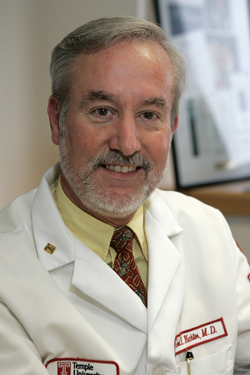A bad chain-link reaction
How a healthy stomach can hurt you
 Photo by Joseph V. Labolito/Temple University
Joel Richter
|
There is a cancer in the United States that isn’t sneaking up on us; it’s already here. Cancer of the esophagus is one of just two cancers that are increasing in this country (skin cancer is the second) and the western world. In fact, figures from the National Cancer Institute show cancer of the esophagus has gone up 400 percent since 1975. And as the cancer spreads, its sufferers aren’t who they used to be.
“Thirty years ago, nearly all of the cancer of the esophagus was occurring in African Americans and people who smoke and drank excessively, since alcohol and tobacco cause cancer,” says Joel Richter, M.D., chair of the Department of Medicine at Temple University School of Medicine and Richard L. Evans Professor of Medicine. “Now, it’s more common in Caucasians, and it’s related to the gastro-esophageal reflux disease, or GERD, epidemic.” The rise of gastro-esophageal reflux is caused by two factors, one of which is tied right to our gut. The obesity epidemic sweeping America is the culprit behind many health issues and extra weight can cause GERD. A second factor is the reduction of the H. pylori bacteria. Though you might think that getting rid of a nasty |
|
bug that causes digestive troubles, stomach ulcers and stomach cancer would be a good thing, eradicating H. pylori through antibiotics has created a “catch-22” in our stomachs. That’s because there is a hidden benefit to having the bug: it destroys the parietal cells of the stomach so it can’t make acid. No acid means no heartburn and fewer cases of GERD and its complications, but as more people have taken medicines to kill H. pylori, they have eliminated the one bacterium that protected them from acid reflux. Together, these factors have caused the rates of GERD to steadily rise; it now afflicts some 20 percent of the adult American population. GERD triggers a number of complications, beginning with damage to the esophagus as it gets narrower and scarred. According to the National Institute of Diabetes and Kidney Diseases, for 700,000 adults, a dangerous chain-link reaction follows, as they next develop Barrett’s Esophagus, which is now the primary factor in the development of esophageal cancer. To put it another way, having Barrett’s means you’re 30 times more likely to develop esophageal cancer. “The sad thing about esophageal cancer is that 95 percent who get it never had an endoscopy and by the time it’s diagnosed, the survival rate is low, “says Richter. “The five-year survival rate is 10-15 percent because the disease is so advanced, but if they had an endoscopy in the earlier stages of GERD, their survival rate increases dramatically. Furthermore, we now have non-surgical techniques to treat these early cancers with survival equal to removing the entire esophagus.” That’s why Richter urges an endoscopy for people suffering from GERD. It can reveal how advanced the acid reflux disease is and which type of treatment is best, from daily proton pump inhibitors to the more rare GERD surgery, which is performed laparoscopically roughly 25,000 times a year. |
|